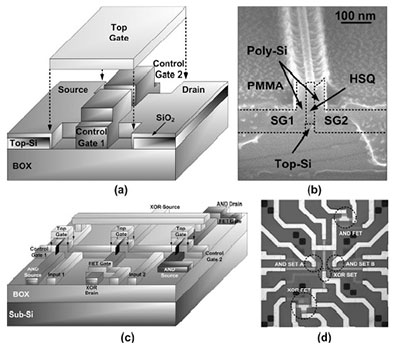Silicon Wafers to Fabricate Single Electron Transistors
What Silicon Wafers are Used to Fabricate Single Electron Transitors
Researcher:
I am using the silicon wafer for fabrication of single electron transistors for quantum tunneling transport.
UniversityWafer, Inc. Quoted:
The following wafers were used:
Si Item #23630
76.2mm P(100) 1-10 ohm-cm SSP 380um with 1 micron of Thermal Oxide
Get Your Quote FAST!
What are Single Electron Transistors?
A single electron transistor is a sensitive electronic device based upon the electron tunneling effect. In this electronic device the electrons move rapidly through a tunnel junction to a quantum dot, which absorbs them and releases them into a medium carrying electric field. When such a device is employed for the synthesis of DNA, proteins or chemicals, it is called a "Quantum processor."
The single electron transistors used in chemical synthesis are called "Molecules." They are composed of a proton and an electron with an orbital around them. In a way, the molecules are similar to gases in that they both have a positive charge and a negative one. Single Molecules may be used as carriers for chemical reactions, as part of an apparatus for controlling chemical reaction, or as detectors for detecting chemical reaction. These devices are used in many applications in scientific research and industry. To demonstrate their importance, these transistors are programmed to perform specific tasks.
The single electron transistor in a semiconductor device is built of a diode and an n-type amino acid. The diode has a negative charge, which attracts the electrons, and a positive charge, which repels them. When the single electron is transported between the two poles of the diode, it produces a voltage across the carrier. This voltage difference between the input and output terminals of the semiconductor determines the polarity of the current passing through the wire.
The operation of this process is illustrated by the butterfly effect. In this process, an electric charge is formed between the terminals of a conductive path and an isolated ring. The charge on the ring is the same at both the input and output terminals, but the current flowing through the ring is now in the opposite polarity. In a similar way, the current at the single input terminal can become zero when the ring is grounded.
Single electron transistors are used to control the current flowing through an electronic circuit by the movement of a single electron. Since the single electron can only exist in one orbit around the atom, any energy transfer requires one or more pairs of electrons. The two types of single electron transistors that have been built into integrated circuits are the bipolar option and the tunneling option. While the bipolar transistors control currents on a single basis, the tunneling type divides the input and output terminals in half, which allows for the generation of different currents.
Bipolar semiconductor devices are based on a structure called the planar bipolar transistor, which allows one bipolar electrode to form a junction with the rest of the device. At room temperature, the semiconductor can be a very stiff substance, which is why it is used in telecommunications equipment. The bipolar device has three inputs, which can include an electrical field that produces a change in the current, a power supply, and a source of electrical energy. The current travels from the input terminals to the output terminals, changing the charge of the semiconductor material. There are some important devices that make use of bipolar transistors to function properly, including microprocessors, photodiodes, medical equipment, television sets, and many other electronic items.
In order for single electron transistors to work in the manner that they do, the smallest number of atoms that make up a semiconductor material must be positioned within an electric field that encompasses the entire semiconductor material. When this electrical field is formed, the electrons are able to simply move between their two orbital arrangements on the surface of the material. Because of this, the amount of energy that is flowing between single orbital locations will determine the overall amount of current that is generated. To change the current level, all that needs to be done is to switch the connection from one level to the next. While this is the most simplistic way of how single electron transistors control the flow of current, other methods have been created to allow the devices to be made to work in more complex manners.
One way in which the single electron transistors can be made more complicated is through the implementation of what is called a molecular switch, which allows the current to be controlled between single and multiple orbital configurations. Another method that is used in many electronics applications involves the use of a conductive metal layer, which can be used to allow current to flow in either direction depending on what the electrical field is. By using a variety of different types of semiconductor materials, single electron transistors can be implemented in a variety of ways to create the exact amount of power that is needed to meet an electronic device's particular function.
